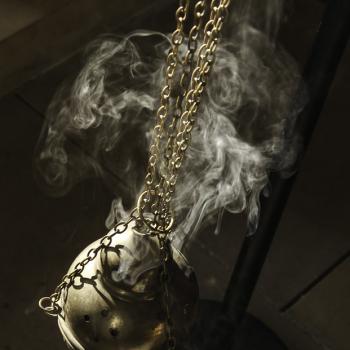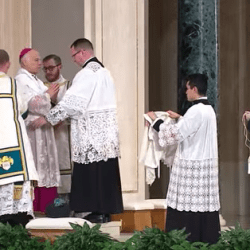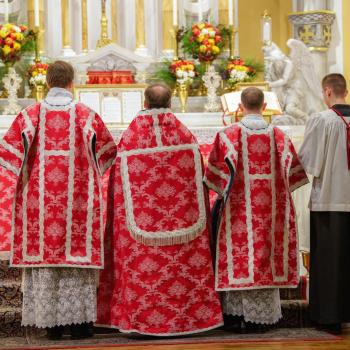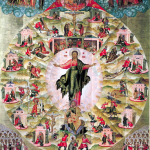This image popped up on my Facebook feed this morning: Brooklyn’s Fr. Carlos Velasquez celebrating his first All Souls Mass as a priest this weekend at St. Sebastian’s in Woodside.
This seems to be a growing trend in the U.S, though I have to admit I’ve never seen it personally; we don’t have any black vestments at my parish.
A couple years back, Fr. Ryan Erlanbush argued in favor of a return to basic black:
Traditionally, black is used at all Masses of the dead and funeral Masses, on All Soul’s Day, and on Good Friday. In the Novus Ordo, black is not to be used on Good Friday, but may still be used at the other Masses (though violet and even white are also permitted, and in practice preferred). There is no reason why a priest could not, in the Novus Ordo begin to use black vestments at least for All Soul’s day – and even for funerals and Requiem Masses.
The theology of a Requiem Mass for the dead
Black signifies mourning, but not simply mourning in general. Rather, black directs us in a particular way to mourn and pray for the dead. While white is a color of festivity and rejoicing, violet is the color which signifies penance and sorrow for sin.
However, violet directs us more to mourning for our own sins, and to performing penance for our own wretchedness. Black, on the other hand, helps to direct us to mourn not for ourselves but for the deceased. This is why black is so fitting for the funeral Mass (as well as Requiems and All Souls’): The color reminds us to pray for the dead.
The funeral Mass is not really about the family – though there are certainly many prayers for the consolation of those who mourn. Rather, the funeral Mass is primarily for him who has died: Nearly every prayer is for the forgiveness of his sin (i.e. of the temporal punishment of sin). Funerals are not primarily for the living, they are for the dead – whatever anyone (even if he be a priest) may tell you! This is why it makes no sense – theologically – to wear either white or even purple for a funeral Mass or Requiem.
A test case: All Saints’ and All Souls’
Consider, as a test case, the feasts of All Saints’ and All Souls’ days. In many (perhaps most) parishes throughout the USA, the faithful see the priest wear the very same vestment for All Souls’ day as he did for All Saints’. What sort of theology does this communicate to the people?
On All Saints’, the priest is directed to wear white vestments because the saints are already in heaven and enjoy the vision of God. They are perfectly happy and have no need of our prayers. All Souls’, however, is the Mass offered for the holy souls in purgatory – it is offered as a prayer in their behalf, for the remission of the temporal punishment they bear for their sins.
Now, if the priest wears white vestments on All Souls’ day, can he be the least bit surprised that his faithful have ceased to believe in the reality of purgatory? If the priest wears the color of festivity, rather than the color of prayerful mourning, who will ever believe that there are any souls who suffer purgation after death?
In my 55 years, I’ve never seen black vestments worn for a funeral or for All Souls; I suspect that’s true for most Catholics of my generation. I have to wonder how mourners who are accustomed to the funeral ritual being conducted in white would react to suddenly seeing it, almost like a photographic negative, in black. The predominant use of white at funerals serves as a reminder of our baptism; the white pall, like the white garment, echoes the moment in the life of the deceased when he or she “put on Christ.” We who are born in Christ also die in him; white is a sign of newness of life, and a symbol of hope. Black suggests something else entirely.
The Order of Christian Funerals, meantime, gives a number of options:
“The liturgical color chosen for funerals should express Christian hope but should not be offensive to human grief or sorrow. In the United States, white, violet, or black vestments may be worn at the funeral rites and at other offices and Masses for the dead” (#39).
Under most circumstances, for a funeral I think it would be prudent (and pastorally sensitive) to let the family of the deceased have a say in the matter.
As for All Souls: why not? Wearing black might be a ripe opportunity for the priest (or deacon) to catechize the faithful and explain the meaning of liturgical colors and remind them why they are important.
I also think there’s something to be said for looking death squarely in the eye. It’s a main reason why, on Ash Wednesday, I always say during the imposition of ashes, “Remember you are dust and to dust you will return.” The other option—”Turn away from sin and be faithful to the gospel”—is fundamentally the same message that is imparted every Sunday, and at every celebration of the Sacrament of Reconciliation.
Once a year, I think, it’s good to be reminded of how our earthly life will end, and add a little more urgency to our call to conversion.
UPDATE: Speaking of liturgy, a reader wrote in to describe the music at his parish this weekend, which included a sung “Gloria” (this, despite the face that the Gloria is to be omitted for All Souls) and “For All the Saints” as a recessional.
At my place, we had “Libera me Domine,” sung as a solo, for a solemn entrance hymn, Handel’s “Since by Man Came Death” for communion, and “I Know That My Redeemer Lives” for the recessional.
The translation of the “Libera me Domine” is especially haunting:
Deliver me, O Lord, from death eternal on that fearful day,
When the heavens and the earth shall be moved,
When thou shalt come to judge the world by fire.
I am made to tremble, and I fear, till the judgment be upon us, and the coming wrath,
When the heavens and the earth shall be moved.
That day, day of wrath, calamity and misery, day of great and exceeding bitterness,
When thou shalt come to judge the world by fire.
Rest eternal grant unto them, O Lord: and let light perpetual shine upon them.
















